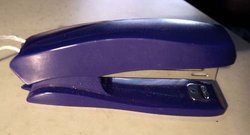Stapler
|
|
StaplerKM.jpg
A stapler is a device which binds together sheets of paper by driving a thin metal staple through the sheets and folding over the ends to secure the paper and avoid injury from the staple's sharp points. It is commonly found in an office or other place that processes large amounts of paper.
| Contents |
History
The first stapler in recorded history was the stapling machine or fastener of King Louis XV of France in the 1700s. Each staple had to be handmade and was inscribed with the insignia of the royal court.
Modern paper fastening devices started with the patent of the first paper fastener on September 30, 1841 by Samuel Slocum. This crude device stuck pins on paper to fasten them. On August 7, 1866, the Novelty Paper Fastener was patented by the Patent Novelty Mfg Co. It allowed a single staple to be loaded and was used to mainly bind papers or books, but also carpet, furniture or boxes. Staples for the fastener were manufactured by the P.N. Mfg Co. in several sizes: 3/16 inches, 1/4 inches, 3/8 inches, and 1/2 inches.
On July 24, 1866, George W. McGill was awarded U.S. Patent No. 56,587 for a small, bendable brass paper fastener, the precursor to the modern staple. On August 13, 1867, he received U.S. Patent No. 67,665 for a press to insert the fastener into paper. He showed his invention at the 1867 Centennial Exhibition in Philadelphia, and continued to work on these and other various paper fasteners through the 1880s. On February 18, 1879, Patent No. 212,316 was given for the McGill Single-Stroke Staple Press. This device weighed over two and a half pounds and was able to load a single 1/2 inches wide wire staple at a time and drive it through several sheets of paper.
Methods of stapling
Permanent fastening
Heavy-duty-stapler-firestone.jpeg
A staple remover is a simple device that can remove staples fastened in this manner, by using a pair of interlocking curved claws that slide under the staple's bent-over ends and bend them back out.
Tacking
This method is used for fastening objects to larger objects, generally bulletin boards or walls. It is achieved by rotating the base of the staple 180 degrees so that staples are driven directly into an object without use of the anvil. Heavy duty tacking with larger staples is done using a staple gun.
Pinning
This method is by far the least known and most rarely used of the stapling methods. It is used to temporarily bind documents or other items, often cloth or clothing for sewing. In order to pin, the anvil must be shifted so that the staple bends outwards instead of inwards. The staple binds the item with relative security, but can be easily removed by pulling the staple along the plane of the paper. This method varies between staplers, as some anvils need to be simply pushed forward to allow pinning, while others must be rotated. Some staplers implement pinning by bending one leg of the staple inwards, while bending the other outwards. Some modern staplers do not even include support for pinning.
Surgery
Surgical, or skin, staplers are frequently used as substitutes for suture. These resemble standard staplers but have smaller jaws. The staples, made from stainless steel, are typically supplied in disposable, pre-sterilised cartridges.
Famous staplers
A well-known stapler is the Red Swingline Stapler from the movie Office Space. It is the prized possession of office worker Milton Waddams, who is pushed towards insanity partially due to his stapler being frequently borrowed by boss Bill Lumbergh. Though Swingline did not actually manufacture a red stapler at the time, the movie's subsequent popularity created a demand for them. Swingline began offering red staplers in 2004.
External links
- The Stapler Database (http://www.calcampus.com/stapler/index.htm) -- The biggest serious website totally about stapler information
- Understanding Your Stapler (http://www.corporateexpress.com/swingline/understanding/solutions.htm) -- A Glossary of Stapler Terms
- The Virtual Stapler (http://www.virtualstapler.com/)
Stapler manufacturers
- Swingline (http://www.swingline.com)
- Hunt (http://www.hunt-corp.com/office/bostonrs/officeframe.html) (Boston & Rapid lines)
- Stanley Bostitch (http://www.bostitch.com/)
- Isaberg Rapid AB (http://www.isaberg-rapid.com/)nl:Nietapparaat

